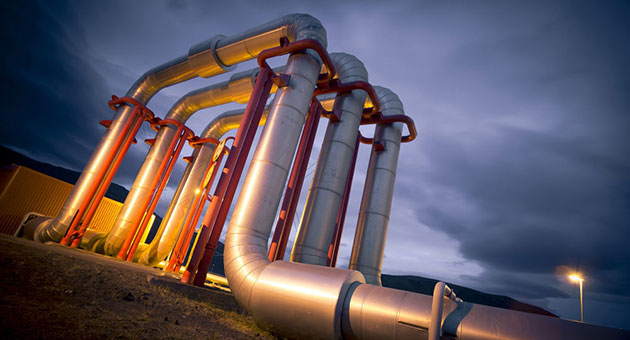The Energy Report: John, falling commodity prices are a symptom of our ailing macroeconomic health today, but master limited partnerships (MLPs) are supposed to be defensive vehicles. Do they still offer protection in these tough markets?
John Edwards: They are still defensive vehicles. But, to be clear, while MLPs generally do not have direct commodity exposure, there are some subsectors that do have direct commodity exposure.
TER: You must be talking about the upstream partners, which have direct commodity-price exposure.
"Because of low natural gas prices, producers are pulling rigs out of the dry gas areas and redeploying them in the wet gas and oily areas. That has generated a lot of demand for storage and other midstream services on the wet gas and oily side."
JE: You have the upstream partners, and you have some gas processors that have direct commodity exposure. The propane providers and suppliers have commodity exposure. The defensive MLPs are in what I would call in the main fairway—contracted pipelines and storage in the areas of crude oil, refined products and natural gas.
TER: That's the classic midstream.
JE: Yes, the classic midstream. They have indirect commodity exposure.
TER: What has been driving a lot of the growth in the MLP sector over the last few years?
JE: The shale revolution on the natural gas-, natural gas liquids- (NGLs) and oil-side has resulted in very strong demand for midstream infrastructure. However, a sustained collapse in commodity prices would start to reduce demand for infrastructure because the upstream producers would not be able to make the rate of return on their efforts to extract product out of the ground. From that standpoint, the growth rates are very much affected over the longer term by the behavior of commodity prices. Clearly, we've been in an environment where oil and liquids have been strong relative to dry gas. There have also been a lot of bottlenecks in the United States' plumbing, and that has put pressure on the midstream segment to address those bottlenecks.
TER: What shifts have you seen in the midstream?
JE: Because of low natural gas prices, we're seeing producers pull rigs out of the dry gas areas and redeploy them in the wet gas and oily areas. That has generated a lot of demand for storage and other midstream services on the wet gas and oily side. We've had a tremendous increase in the demand for the liquids side of the business.
TER: We've seen some significant weakness in MLP unit prices. Shouldn't we be seeing more consolidation now with these weak prices?
"From a valuation standpoint, we now view this sector as quite attractive. We base that valuation on the yield spread between the sector and the U.S. 10-year Treasury."
JE: That's a good question. If you look back to 2008–2009, we saw what amounted to a collapse in unit prices at that time. There were a number of companies that could have been acquired for what would amount to a bargain by today's standards. But the reality is that because of the MLP structure, it's more difficult to get mergers and acquisitions done because of the fact that you have to get approvals from both the general partner and limited partner boards, in addition to going through a review from the conflicts of interests committees, which becomes rather cumbersome with MLPs. More parties are involved, which makes it more complicated. That said, we have had a number of transactions here recently—more than what we've had in quite some time.
TER: Because some of these companies in your coverage universe are rated Outperform, I'm assuming that you believe that income-seeking investors should be in MLPs. Why?
JE: There are a couple of points I think investors should keep in mind. One is that from a valuation standpoint, we now view this sector as quite attractive. We base that valuation on the yield spread between the sector and the U.S. 10-year Treasury. When the spread is above 400 basis points (or 4 percentage points), the sector has a history of delivering above-average returns in the ensuring 12 months. In fact, it's on average over 40%. Right now, we're above 500 basis points in terms of yield spread, and we've never had a losing 12 months when the yield spread has exceeded 465 basis points. When the spread has been between 500 and 549 basis points, returns have averaged 40%. But that's an average, and you also have to take existing conditions into account. For example, the U.S. 10-year Treasury is obviously near record lows. It closed recently around 1.5–1.6%. This very low number contributes to the very wide yield spread. What's embedded in our assumption is that you're going to have a narrowing of that yield spread, ultimately because the U.S. 10-year yield is going to have to rise at some point, which dampens our expectations for returns matching their past history.
With that in mind, I would suggest that the total return outlook for the next 12 months is somewhere in the 18–32% range, which assumes somewhere in the neighborhood of a 5–8% distribution (MLP payout) growth over the next 12-months. If you want to take a more conservative view, your returns would still be in the mid-teens over the next 12-months.
TER: What index are you using to determine the MLP yield?
"What makes these more defensive names is that if the majority of revenue is from fixed-fee contracted assets, then you have much less vulnerability to macroeconomic events."
JE: We use the Alerian MLP Index (AMZ:NYSE), which is a market-weighted index. If you looked at a simple index average, it would be higher, but the main point we wanted to get across here is we have a yield target for the sector of 5.75–6.25%, with a yield of 1.5–1.6%-for the U.S. 10-year Treasury, the targeted yield spread is still extraordinarily high. Historically, the most commonly occurring yield spread is in the 200-250 basis point range with an average of approximately 300 basis points.
TER: John, what are the risks now?
JE: Given the current environment we're in, some of the risks are macroeconomic and therefore non-diversifiable risks. Investors are generally pretty well aware of these, but I think it bears getting them out there on paper so we're all on the same page. There's clearly the European situation, and there are sovereign debt risks. There's been a lot of talk about Greece, and now Spain is in the headlines. Growth has been slowing in China and there is the fiscal cliff in the U.S. All of these issues are likely to weigh on economic growth and in turn on the demand for commodities like oil and NGLs. This in turn can weigh on demand for the mid-stream energy infrastructure provided by MLPs, thereby resulting in a slowing of the distribution growth outlook.
TER: What are the features that make an MLP less risky? What are the best defenses an MLP can offer?
JE: Great question. What makes these more defensive names within a sector that's already defensive is that if the majority of revenue is from fixed-fee contracted assets, then you have much less vulnerability and exposure to these non-diversifiable macro events. The reality is that even in the financial crisis of 2008–2009, people still heated their homes if it was cold, took showers and cooked meals, and electric utilities still used natural gas for electric power generation, so natural gas use was relatively stable. Petroleum use is relatively stable. People may not drive quite as much, but even during those challenging times, the drop in refined products volumes was relatively low, all things considered. And with drops in demand with FERC-regulated assets, owners can request rate adjustments to keep whole on operations, though as a practical matter we did not see much in the way of rate applications from operators of refined product pipelines that were experiencing some single-digit volume falls. Contracts on pipelines are often largely capacity charges, and so there's not a whole lot of volumetric risk associated with these contracted pipelines. That means you have very stable and predictable cash flows from the assets that some of these companies own and operate.
TER: So, does this contracted, fixed-fee structure mean revenue visibility?
JE: Yes. That's right. You have highly visible growth opportunities. But by "fixed fees," what I mean is we're looking for those companies that have the large majority of their cash flow coming from fixed-fee contracted assets.
TER: So, fixed-fee assets are the prime directives for investors. Is that right?
JE: Yes. Protecting your downside is principle number one. Principle number two is that while protecting your downside, look for names that also have a degree of visible growth. In effect, you are supporting a team that has first and foremost a strong defense, but that also has a reasonably strong offense.
TER: It doesn't sound like we're talking about small-cap companies here.
JE: We are not focused on small-cap companies right now. We think the overweight positions in an MLP portfolio should be among the larger caps.
TER: Can you find all these defensive characteristics in single companies, or do you have to diversify among companies to find them all?
JE: You can find it all in some of the companies, but you're better off putting together a portfolio of companies so that you have a greater chance of achieving a reliable cash-flow stream over the long term.
TER: What companies fit these stats?
JE: Given the macro backdrop that we've been talking about, one of the companies that we think should be on investors' radar screens would be in the Kinder Morgan family. There are three tickers associated, and they are Kinder Morgan Management, LLC (KMR:NYSE), Kinder Morgan Energy Partners L.P. (KMP:NYSE) and Kinder Morgan Inc. (KMI:NYSE). Kinder Morgan Energy Partners LP has a very large and diversified set of businesses, with approximately 80% of its cash flows based on stable contracted assets. To the extent that there is commodity exposure in one of its business units, that commodity exposure is substantially hedged. Kinder Morgan Energy Partners LP and Kinder Morgan Management LLC are economically equivalent, except that Kinder Morgan Management LLC pays its distributions in the form of more stock and not in cash and investors receive a 1099 instead of a K-1. Kinder Morgan Energy Partners LP pays the distributions in cash, but Kinder Morgan Management LLC trades at a substantial discount to Kinder Morgan Energy Partners LP. Recently, Kinder Morgan Management LLC was trading at over $5 per unit discount to Kinder Morgan Energy Partners LP, even though it shouldn't make any difference from an economic standpoint. They ought to be roughly equivalent. Kinder Morgan Inc. is a C-Corp, not an MLP, but it owns the general partner to Kinder Morgan Energy Partners LP. We are looking for substantial dividend growth from Kinder Morgan Inc. in the low- to mid-teens going forward.
"While protecting your downside, look for names that also have a degree of visible growth."
We also like Enterprise Products Partners L.P. (EPD:NYSE) because of its large size, balance sheet strength, large asset footprint, visible growth opportunities, solid distribution growth opportunities and high percentage of fee-based cash flows in its asset mix. About 78% of its business is fee-based, and that's growing to about 80% by next year.
TER: That sounds like the kind of limited commodity risk you were just addressing.
JE: Yes, that helps insulate it from commodity price swings. It is our belief that that this growth will be sustainable through difficult macroeconomic conditions. It proved its mettle during the 2008 financial crisis.
TER: Another one?
JE: There's also Plains All American Pipeline L.P. (PAA:NYSE). It's involved in oil transportation and storage. It has similar characteristics to Enterprise Products Partners, although it's on the higher-end for its distributions growth outlook. It's a smaller market cap of about $12 billion ($12B), versus Enterprise at about $43B. Plains All America was recently trading at a yield of 5.4%. It has very visible growth prospects, but it is also very defensive in nature. It held up quite well during the financial crisis. Its balance sheet is actually as strong as it's ever been, so it's well positioned to withstand difficult market conditions.
TER: John, your defensive theme is really interesting given current global conditions. There are clearly not a lot of companies that can meet the criteria.
JE: You know, there are some of the other names that may not necessarily be Outperform-rated, but they're very defensive and provide substantial downside protection to investors.
TER: Go ahead. I'd like to hear them.
JE: For example, Magellan Midstream Partners L.P. (MMP:NYSE). It's trading at about a 5% yield, and we're looking for about a 9% distribution growth outlook with a mid- to high-teens total return outlook, which is perhaps on the lower end of the sector. But if things really get difficult, it's good to know that Magellan had very limited downside during 2008. Again, it's very defensive, but with a good offense as well.
Let me mention one more, Outperform-rated ONEOK Partners L.P. (OKS:NYSE). While it has some exposure to commodity prices, the majority of its cash flows is fixed-fee. It also has very visible growth prospects. Management has issued guidance for a mid-teens distribution growth outlook over the next year. Considering the difficult macroeconomic environment, that certainly gives a solid degree of downside protection.
TER: Thank you for sharing your strategies.
JE: My pleasure.
John Edwards joined Credit Suisse in April 2012 as a director and senior equity research analyst covering publicly traded MLPs involved in energy and energy infrastructure along with pipeline companies and companies that own the general partners to energy MLPs. Prior to joining Credit Suisse, Edwards was senior vice president and senior equity research analyst for Morgan Keegan & Company Inc. Edwards also worked in equities research with Deutsche Bank securities as a vice president and senior analyst covering natural gas pipelines. He received his Bachelor of Arts in economics from Occidental College and a Master of Business Administration from California State University, Fullerton. He is a member of the Financial Analysts Society of Houston, Texas.
Want to read more exclusive Energy Report interviews like this? Sign up for our free e-newsletter, and you'll learn when new articles have been published. To see a list of recent interviews with industry analysts and commentators, visit our Exclusive Interviews page.
DISCLOSURE:
1) George S. Mack of The Energy Report conducted this interview. He personally and/or his family own shares of the following companies mentioned in this interview: None.
2) The following companies mentioned in the interview are sponsors of The Energy Report: None. Streetwise Reports does not accept stock in exchange for services. Interviews are edited for clarity.
3) John Edwards: I personally and/or my family own shares of the following companies mentioned in this interview: None. I personally and/or my family am paid by the following companies mentioned in this interview: None. I was not paid by Streetwise Reports for participating in this story.




























































